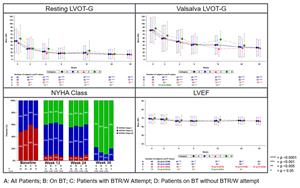Cytokinetics Presents New Data From REDWOOD-HCM OLE in Late Breaking Clinical Trial Session at the HCM Society Scientific Sessions
Patients in REDWOOD-HCM OLE were classified as receiving standard of care therapy if they were being treated with at least a beta-blocker, non-dihydropyridine calcium channel blocker, or disopyramide. Patients were eligible for background therapy reduction/withdrawal (BTR/W) at the discretion of the site investigator, only after Week 12 and after having received a stable dose of aficamten for at least four weeks. Of 42 patients enrolled at the time of this analysis, 39 (93%) were taking ≥1 standard of care medication, and of those, 27 (69%) were receiving a beta-blocker only, 4 (10%) were receiving a calcium channel blocker only, 7 (18%) were receiving disopyramide and either a calcium channel blocker or beta-blocker, and 1 patient (3%) was receiving all three therapies. Of the 35 patients who had completed treatment with aficamten through Week 12, BTR/W was attempted in 20 patients. 17 patients (85%) achieved successful BTR/W, defined as at least one dose reduction of one medication to ≤50% of the baseline dose. Ten patients completely discontinued at least one medication, and 5 withdrew from all standard of care therapies. BTR/W was unsuccessful in three patients, who reinstituted a beta-blocker as a result of recurrence of symptoms or elevated left ventricular outflow tract gradients (LVOT-G). NYHA functional class and NT-proBNP and high-sensitivity troponin I levels remained stable before and after BTR/W. In 14 patients with an available assessment before and after BTR/W, BTR/W resulted in an increase in resting heart rate of 12 bpm (mean HR=74 ±10 bpm, p=0.0001) and Valsalva LVOT-G of 15 mmHg (mean Valsalva LVOT-G=42 ±26 mmHg, p=0.02). These data suggest that patients who achieved successful BTR/W experienced similar benefits from treatment with aficamten as those who remained on background standard of care therapy, and warrants further study.
A photo accompanying this announcement is available at https://www.globenewswire.com/NewsRoom/AttachmentNg/7702de66-eaab-4997-92c5-4512c51cb4c6
“Standard of care medications used to treat HCM often have undesirable side effects. It’s encouraging to see this initial data suggesting that some patients treated with aficamten can reduce or cease treatment of background therapies and still experience substantial improvement in clinically relevant measures of efficacy,” said
About Aficamten
Aficamten is an investigational selective, small molecule cardiac myosin inhibitor discovered following an extensive chemical optimization program that was conducted with careful attention to therapeutic index and pharmacokinetic properties and as may translate into next-in-class potential in clinical development. Aficamten was designed to reduce the number of active actin-myosin cross bridges during each cardiac cycle and consequently suppress the myocardial hypercontractility that is associated with hypertrophic cardiomyopathy (HCM). In preclinical models, aficamten reduced myocardial contractility by binding directly to cardiac myosin at a distinct and selective allosteric binding site, thereby preventing myosin from entering a force producing state. The development program for aficamten is assessing its potential as a treatment that improves exercise capacity and relieves symptoms in patients with HCM as well as its long-term effects on cardiac structure and function. Aficamten received Breakthrough Therapy Designation for the treatment of symptomatic obstructive HCM from the
About Hypertrophic Cardiomyopathy
Hypertrophic cardiomyopathy (HCM) is a disease in which the heart muscle (myocardium) becomes abnormally thick (hypertrophied). The thickening of cardiac muscle leads to the inside of the left ventricle becoming smaller and stiffer, and thus the ventricle becomes less able to relax and fill with blood. This ultimately limits the heart’s pumping function, resulting in symptoms including chest pain, dizziness, shortness of breath, or fainting during physical activity. A subset of patients with HCM are at high risk of progressive disease which can lead to atrial fibrillation, stroke and death due to arrhythmias.
About
For additional information about Cytokinetics, visit www.cytokinetics.com and follow us on Twitter, LinkedIn, Facebook and YouTube.
Forward-Looking Statements
This press release contains forward-looking statements for purposes of the Private Securities Litigation Reform Act of 1995 (the "Act").
CYTOKINETICS® and the
Contact:
Senior Vice President, Corporate Communications, Investor Relations
(415) 290-7757

Source: Cytokinetics, Incorporated





